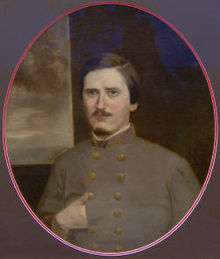Orphan Brigade
The Orphan Brigade was the nickname of the First Kentucky Brigade, a group of military units recruited from Kentucky to fight for the Confederate States of America during the American Civil War. The brigade was the largest Confederate unit to be recruited from Kentucky during the war. Its original commander was John C. Breckinridge, former United States Vice President and candidate for president, who was enormously popular with Kentuckians.
| First Kentucky Brigade | |
|---|---|
| Active | 1861–1865 |
| Country | |
| Allegiance | Kentucky |
| Branch | |
| Size | Brigade |
| Nickname(s) | "Orphan Brigade" |
| Arms | Enfield rifled muskets |
| Engagements | American Civil War
|
| Commanders | |
| Commanding officers |
|
History
The regiments that were part of the Orphan Brigade were the 2nd, 3rd, 4th, 5th, 6th, and 9th Kentucky Infantry Regiments. Units of the Orphan Brigade were involved in many military engagements in the American South during the war, including the Battle of Shiloh. In 1862, Breckinridge was promoted to division command and was succeeded in the brigade by Brig. Gen. Roger W. Hanson. At the Battle of Stones River, the brigade suffered heavy casualties in an assault on January 2, 1863, including General Hanson. Breckinridge—who vehemently disputed the order to charge with the army's commander, General Braxton Bragg—rode among the survivors, crying out repeatedly, "My poor Orphans! My poor Orphans," noted brigade historian Ed Porter Thompson, who used the term in his 1868 history of the unit. The name came from how the Confederacy viewed its soldiers from Kentucky (which remained in the Union, but was represented by a star in both countries' flags).[1] The term was not in widespread use during the war, but it became popular afterwards among the veterans.
The Orphan Brigade lost another commander at the Battle of Chickamauga, when Brig. Gen. Benjamin H. Helm, Abraham Lincoln's brother-in-law, was mortally wounded on September 20, 1863, and died the following day. Major Rice E. Graves, the artillery commander, was also mortally wounded.[2]
The Orphan Brigade served throughout the Atlanta Campaign of 1864, then were converted to mounted infantry and opposed Sherman's March to the Sea. They ended the war fighting in South Carolina in late April 1865, and surrendered at Washington, Georgia, on May 6–7, 1865.[3]
 Brig. Gen. John C. Breckinridge commanded the Kentucky Brigade until 1862
Brig. Gen. John C. Breckinridge commanded the Kentucky Brigade until 1862.jpg) Brig. Gen. Benjamin H. Helm was mortally wounded while leading the Kentucky Brigade at Chickamauga
Brig. Gen. Benjamin H. Helm was mortally wounded while leading the Kentucky Brigade at Chickamauga
Arms
When the Orphan Brigade was mustered into service, weapons were in short supply. The troops were armed with old smoothbore muskets (some flintlock and others percussion) along with shotguns and hunting rifles (Hawkens). They were given a bounty if they brought their own rifle. Some men had no arms at all. Only a week before the Battle of Shiloh, every regiment except the 9th Kentucky was issued a supply of Enfield rifles imported from England (the 9th armed themselves with Enfields captured during the battle).
From that point onward, most of the Orphan Brigade carried the long three-band Model 1853 Enfield rifle. When the unit surrendered in March 1865, some men were still carrying the same rifles they had had since Shiloh.
Organization
The original units of the Orphan Brigade

- 2nd Kentucky Infantry, organized at Camp Boone, July 17, 1861
- 3rd Kentucky Infantry, organized at Camp Boone, July 20, 1861
- 4th Kentucky Infantry, organized at Camp Burnett, September 13, 1861
- 6th Kentucky Infantry, organized at Bowling Green, November 19, 1861
- 9th Kentucky Infantry, organized at Bowling Green, Kentucky October 3, 1861, as the 5th Kentucky Infantry (Preliminary organization; final organization not complete until May 15, 1862.[4])
- Cobb's Battery, organized at Mint Springs, Kuttawa, Kentucky, 1861 (After a period of training at Camp Boone the troops moved to Bowling Green, Ky. in September 1861 and The First Kentucky Battery was formally brigaded under Gen. John C. Breckinridge)
- Graves' Battery, commanded by Major Rice E. Graves, Jr., organized at Bowling Green, November 8, 1861
- Byrne's Artillery Battery, organized in Washington County, Mississippi, July 1861. (Disbanded during summer 1862, at Vicksburg, Mississippi, with men and guns being transferred to Cobb's Battery.)
- Morgan's Men, organized at Bowling Green, November 5, 1861
Other units that joined the Orphan Brigade
- 5th Kentucky Infantry
- 41st Alabama Infantry (fought as part of the Orphan Brigade at Murfreesboro, the Siege of Jackson and Chickamauga)
- 31st/49th Alabama Infantry
Formally in but not directly serving with
- 1st Kentucky Cavalry, organized at Bowling Green 1861
Notable members
Source:[5]
- John C. Breckinridge
- Marcellus Jerome Clarke (a.k.a. Sue Mundy)
- Benjamin H. Helm
- John Hunt Morgan
- Rice E. Graves, Jr.
- Alexander Goldsmith Brawner
- James W Hoffler
See also
- List of Kentucky Civil War Confederate units
- Kentucky in the Civil War
Notes
- Georgia Historical Commission, http://www.spaldingcounty.com/historical_markers/picture12_cropped.jpg Archived November 30, 2010, at the Wayback Machine
- Hughes, pp. 79–83, 87–88, 90–95, 105, 113–116, 120–121, 124–125, 133, 135, 137–139.
- Thompson, 1898 ed.
- Thompson, 1898 ed., p. 434
- "Page 1050 of History of the Orphan brigade - Kentucky Digital Library". Kdl.kyvl.org. Retrieved February 2, 2016.
References
- Hughes, Nathaniel Cheairs, Jr., The Pride of the Confederacy: The Washington Artillery in the Army of Tennessee, Louisiana State University Press, 1997, ISBN 0-8071-2187-8.
- Thompson, Edwin Porter (1868). History of the First Kentucky Brigade. Cincinnati, Ohio: Caxton Publishing House.
- Thompson, Edwin Porter (1898). History of the Orphan Brigade. Louisville, Kentucky: L. N. Thompson.
- Davis, William C. (1980). The Orphan Brigade: The Kentucky Confederates Who Couldn't Go Home. Garden City, NY: Doubleday.
External links
- First Kentucky (Orphan) Brigade Homepage
- The Orphan Brigade historical marker